

I Heard It Through the Grapevine. "I Heard It Through the Grapevine" is a song written by Norman Whitfield and Barrett Strong for Motown Records in 1966, and made famous by Marvin Gaye in a single released in October 1968 on Motown's Tamla label.
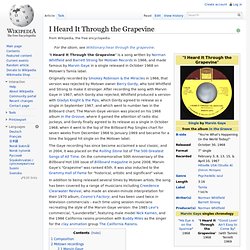
In addition to being released several times by Motown artists, the song has been covered by a range of musicians including Creedence Clearwater Revival, who made an eleven-minute interpretation for their 1970 album, Cosmo's Factory; and has been used twice in television commercials – each time using session musicians recreating the style of the Marvin Gaye version: the 1985 Levi's commercial, "Launderette", featuring male model Nick Kamen, and the 1986 California raisins promotion with Buddy Miles as the singer for the clay animation group The California Raisins.
Dirty Deeds Done Dirt Cheap. It was originally released in Australia on Albert Productions on 20 September 1976.
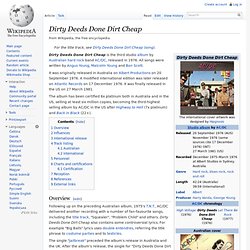
A modified international edition was later released on Atlantic Records on 17 December 1976. It was finally released in the US on 27 March 1981. The album has been certified 6x platinum both in Australia and in the US, selling at least six million copies, becoming the third-highest selling album by AC/DC in the US after Highway to Hell (7x platinum) and Back in Black (22+). Overview[edit] Influences[edit] Furthermore, the term "Dirty Deeds Done Dirt Cheap" is an homage to the cartoon Beany and Cecil, which Angus watched when he was a child. International release[edit] The international edition of Dirty Deeds Done Dirt Cheap, released on 17 December 1976, is considerably different from the original Australian edition, and features a different cover and track order.
On this album, the singles "R.I.P. 03- Dirty deeds done dirt cheap by miubu. Style: The Art of Writing Well - F. L. Lucas. Rita Hayworth, 1940s Prints at AllPosters. Not Available Sorry, the specific item you were looking for is no longer available.
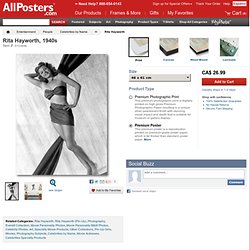
May we recommend the item below instead? Www.allposters.com/-sp/Rita-Hayworth-1940s-Posters_i5103696_.htm Don't see what you like? Customize Your Frame Custom Frame Studio Close X false div_lc_sb_fs_01| Chat Link Clicked|44802| Rita Hayworth, 1940s Item #: 5103696 Note - The watermark above (\AllPosters\") will not appear on the artwork itself. Tell a Friend about this Product About the Product About the Artist Customer Reviews Size Trim Border Product Type This premium photographic print is digitally printed on high gloss Premium Photographic Paper resulting in a unique silver pearlescent finish with stunning visual impact and depth that is suitable for museum or gallery display.
About Canvas An affordable alternative to original art, canvas pops off the wall with rich texture, color and detail. About Wood Mount Bond your art to a thick piece of beveled hardboard for a clean and sleek style. About Laminate Add to Cart. Geologist's hammer. A geologist's hammer with tubular shaft and chisel head A geologist's hammer used to break up rocks, as well as a scale in the photograph A geologist's hammer, rock hammer, rock pick or geological pick is a hammer used for splitting and breaking rocks.
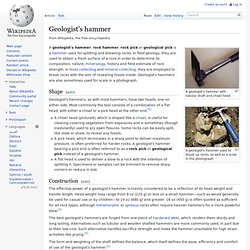
In field geology, they are used to obtain a fresh surface of a rock in order to determine its composition, nature, mineralogy, history and field estimate of rock strength. In fossil collecting and mineral collecting, they are employed to break rocks with the aim of revealing fossils inside. Geologist's hammers are also sometimes used for scale in a photograph. Shape[edit] Geologist's hammers, as with most hammers, have two heads, one on either side. A chisel head (pictured), which is shaped like a chisel, is useful for clearing covering vegetation from exposures and is sometimes (though inadvisedly) used to pry open fissures. Rita Hayworth. Hayworth appeared in a total of 61 films over 37 years.
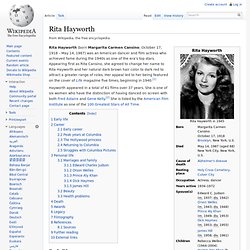
She is one of six women who have the distinction of having danced on screen with both Fred Astaire and Gene Kelly.[2] She is listed by the American Film Institute as one of the 100 Greatest Stars of All Time. Early life[edit] Hayworth was born in Brooklyn, New York in 1918 as Margarita Carmen Cansino, the oldest child of two dancers. Her father, Eduardo Cansino, Sr., was from Castilleja de la Cuesta, a little town near Seville, Spain.[3] Her mother, Volga Hayworth, was an American of Irish-English descent who had performed with the Ziegfeld Follies.[4] The couple married in 1917.
They also had two sons: Eduardo Jr. and Vernon Cansino.[4][5] Margarita's father wanted her to become a professional dancer, while her mother hoped she would become an actress.[6] Her paternal grandfather, Antonio Cansino, was renowned as a Spanish classical dancer. Career[edit] Early career[edit] Publicity photo 1940 Peak years at Columbia[edit]